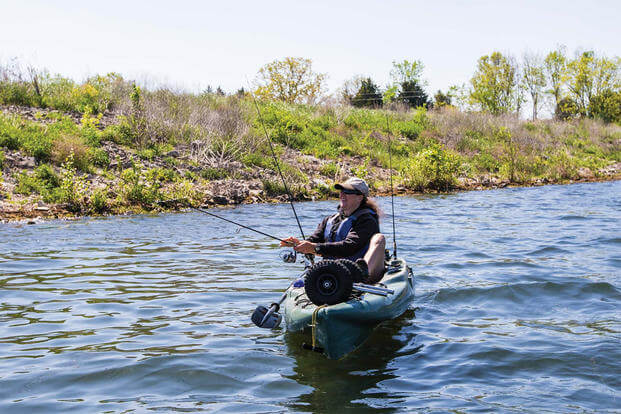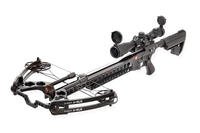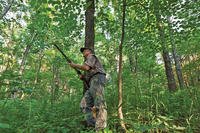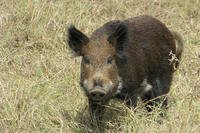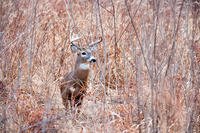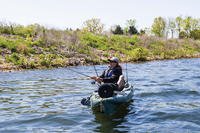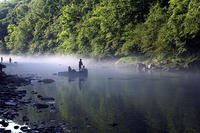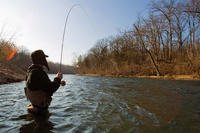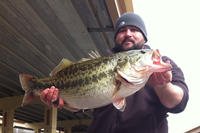Kayak fishing is not only a great way to get back in touch with nature, but a great way to protect the environment and save a few dollars in fuel costs along the way. To get "off the beach" by conventional boat standards will cost you upward of a second mortgage. However, you can climb into a kayak and be afloat with your tackle for under $1,000. Best of all, it can be one of the most successful way to fish shallow water.
Hull Design
Before choosing a kayak, you need to consider several factors. What type of water are you mostly fishing? Is the local lake or bay system centralized or do you have fairly large areas of water to paddle? Are you looking for a stable casting platform or a sleek, fast-moving boat to chase blitzing schools of fish?
Kayaks come in two basic styles. If you're looking to cover large expanses of water of a mile or more, you might want to consider a hull design from 12 to 18 feet long. The longer hull design, although more of a portage challenge as compared to shorter versions, is a more efficient, wave-breaking machine. The longer hull design acts as a wave buffer and increases your paddling and speed efficiency. However, what you make up for in paddling ease and speed, you lose in maneuverability and casting stability. Longer boats tend to have a shorter beam, or the distance across the widest part of the boat, and might wallow or rock more.
If stability is crucial, such as what's needed for fly-fishing or beginners, consider going for a shorter boat in the 8- to 12-foot range. Shorter boats tend to carry more of their width closer to the tail and nose—imagine an oval-shaped boat rather than a sleek arrow-shaped design. If you want superior stability, but need to cover big water, you can do like I've done and store the kayak on a skiff and haul it to a fishing hole. I then launch and paddle a short distance into a back lake. Thus, if you tend to have a larger fishing area, need to cover great distances of water to get to different holes and storage space is at a premium, a shorter boat might still fit the bill. Also, the stability of a shorter boat can afford the more daring angler to stand atop the boat and get a better look into the water.
Paddle Design
Paddles come in a plethora of styles and types. The most important factors to consider when choosing a paddle are strength and efficiency. You're the motor behind this toy, so you want a paddle that best fits you and your paddling style.
Consider spending a few dollars on a carbon-fiber paddle and being properly fitted to the paddle. Carbon-fiber paddles are more durable than aluminum or plastic, and are more rigid.
Ask a local kayak dealer what blade type he recommends. A short narrow blade will be lighter and offer less wind resistance but will sacrifice some "bite" on the paddle stroke. A longer, wider blade will exhibit greater wind resistance, but will be more efficient in the water. The choice depends on local water, as well as fishing, conditions, so ask the locals for advice.
Rigging
Comfort, dryness and purpose are the key factors to rigging your kayak for your days on the water. To be comfortable, you need a lot of stuff, including lunch, drinks, a first-aid kit, maps and fishing gear. And you want to keep your gear dry. Buy and use a midsized duffle, preferably one designed to be watertight, two medium-sized bags that will fit in the duffle and four smaller bags for eyeglass/sunglass cleaners, cameras, money, cell phones or VHF Radios.
Also, buy an assortment of bungee lanyards, leashes and tiedowns, and keep two 18-foot sections of rope with you at all times. Tie down and leash everything. A good rule of thumb: if it's not built into the kayak, tie it down.
Most fishing kayaks have built-in rod tubes. However, if your kayak doesn't have one, buy one. Typically, it's best to take two rods. If you're not using one, place it in the rod holder and tie it down with a rod lanyard. Many kayak anglers have one rod set up with a sub-surface rig and the other with a topwater rig. As conditions change, it's easy to grab either rod.
Tackle, maps, GPS and communication devices should be rigged between your knees and readily accessible. Here again, dry bags are essential.
Safety
If you're a kayak fisherman, a rollover is inevitable. When it happens, don't panic. Remember, everything should already be tied to the kayak, and if it isn't, you'll only loose tackle. That can easily be replaced. Stay calm and remember you're a prepared kayaker — you never leave the dock or wading area without wearing a PFD. Word of advice, don't use a water-induced inflation device. If you do … it will go off — typically in the middle of a long technical paddle.
Moreover, never hit the water until you've notified someone where you'll be fishing, for how long and when you expect to return. For added protection, always post the information on your car window in case of an emergency. Be sure to pack a standard Coast Guard first-aid kit with flares, a noise-making device, a cellphone and a waterproof GPS unit. On a kayak, safety should always be your utmost concern.
Kayaking can be an exhilarating experience. With kayaks fitted with every form of fishing warfare known to man, anglers are now using the oldest mode of water navigation to fight fish in rivers, lakes, bays and intracoastal waterways. Some fisherman are even venturing out into the deep to battle tuna, sharks and other big game species commonly thought to only be the quarry of larger long-range boats. Kayaks have arrived. Get outside and get ready to see your fishing success improve.
Resources:
Texas Kayak Fisherman Forum
Visit texaskayakfisherman.com
Saltwater Kayak Fishing
The Texas Way is a great introduction to the sport from a teacher's perspective.
Visit captainsally.com.
Kayak Adventure
Check out Aaron Reed's epic Texas paddle from the Rio Grande to Sabine Lake—the entire length of the Texas Coast. His blog and other useful kayaking resources can be found at waterwilderness.blogspot.com.
Paddling Web site and Forum
This Web site has an online forum with a thread titled "Fishing From Kayaks and Canoes," that is an excellent place to ask questions and get advice on products, gear and fishing information from experienced paddlers.Visit paddling.net.
Dry Storage:
These companies offer a line of products to keep all your gear dry.
Seal Line, seallinegear.com
Otter Box, otterbox.com
Pelican Products, pelicanproducts.us
A Few Kayaks To Consider:
Ocean Kayak Prowler 15
The Ocean Kayak Prowler 15 sports a longer water line provides greater speed and is built with distance paddles in mind. The Prowler 15 is suitable for traveling big expanses of water and chasing a blitzing school of fish.
| Length | 15 feet, 4.5 inches |
| Width | 28.5 inches |
| Seath Width | 19.5 inches |
| Weight | 56 pounds |
| Max Capacity | 400-450 pounds |
| Suggested Retail | $799 |
Hobie Mirage Outback Fish
The Mirage Drive System powers the Hobie Mirage Outback Fish. This allows the angler to keep his hands free to fish while the boat is propelled using foot power.
| Length | 12 feet, 1 inches |
| Width | 33 inches |
| Weight | 62 pounds |
| Max Capacity | 400 pounds |
| Suggested Retail | $1,649 |
Malibu Kayaks – Pro Explorer
The Pro Explorer is designed for easy paddling, stability, fishing, diving, and is stackable for easy storage.
| Length | 12 feet, 6 inches |
| Width | 31 inches |
| Weight | 52 pounds |
| Max Capacity | 450 pounds |
| Suggested Retail | $769 and up |
NuCanoe Adventure10'
The NuCanoe offers great stability with its 42-inch-wide hull. The Adventure series can be equipped with a trolling motor as well.
| Length | 10 feet |
| Width | 42 inches |
| Weight | 65 pounds |
| Max Capacity | 425 pounds |
| Suggested Retail | $949 |
